Archive for category July 2019
Ha!! On Predictions by Experts
Posted by admin in July 2019, Past issues on July 2, 2019
In the absence of our own understanding of the science and technology behind many inventions, we look for experts in the field to project the shape of things to come in the field of their expertise in the implicit assumption that they have better insights into the future looking through their special crystal balls. How innocent we are in our assumption and belief and how wrong these experts have been!. Here is a list culled from diverse sources:
“Rail travel at high speed is not possible because passengers, unable to breath would die of asphyxia.â€Â — Dr. Dionysius Larder Professor of Natural Philosophy, University college of London (1783-1859)
“Heavier-than-air flying machines are impossible.†— Lord Kelvin, British mathematician and physicist, president of the British Royal Society, 1895. The absolute temperature scale (0 Celsius = 273 Kelvin) is named in his honor!.
‘The horse is here to stay, but the automobile is only a novelty — a fad.â€Â  — The president of the Michigan Savings Bank advising Henry Ford’s lawyer to not invest in the Ford Motor Company (1903)
“The cinema is little more than a fad. It’s canned drama. What audiences really want to see is flesh and blood on the stage.†— Charlie Chaplin (20th century.)
“Who the hell wants to hear actors talk?â€â€™ — H.M. Warner co-founder of Warner Brothers
“There is no reason for any individual to have a computer in his home.†— Ken Olson, chairman and founder of Digital Equipment Corporation.
“With over fifteen types of foreign cars already on sale here, the Japanese auto industry isn’t likely to carve out a big share of the market for itself.†— Business Week, 1968.
“640kB should be enough for anyone.†— Bill Gates, 1981
“The world potential market for copying machines is 5,000, at most,†— IBM to Xerox in 1959.
“The concept is interesting and well-formed, but in order to earn better than a ‘C’, the idea must be feasible.†— Yale professor to the founder of FedEx Fred Smith when he was a MBA student. ♠
Home:
High-Protein Low-Carb Idlies
Posted by admin in July 2019, Past issues on July 2, 2019
By K S Venkataraman ThePatrika@aol.com
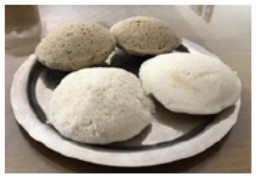
Indian dals contain proteins between 15% and 25%. Protein-rich dals have low glycemic indexes compared to white rice. The proteins in individual dals, made up of amino acids as building blocks, do not contain all the nine essential amino acids (histidine, isoleucine, leucine, lysine, etc.) our body needs. Hence vegetarians need a combination of several dals plus seeds/nuts, tofu, and milk products to get complete proteins.
I. Ingredients:
In the list below, broken lentils with the husk/skin intact are given because they soak quicker. Unbroken lentils are a better choice, but they need longer soaking times. The husk/skin is a good source of fiber.
1. Chana dal: 1 measure (use any volume measure)
2. Toor dal: 1 measure
3. Broken sabut Urad with the husk/skin intact): 1 measure
4. Broken sabut moong with husk: 1/2 measure
5. Broken Red Mung Beans: 1/2 measure
6. Boiled rice (this is not parboiled rice and not cooked rice): 2 measures. Note: This is a unique South Indian rice available in Indian stores. One brand is Ponni Puzhungal Arisi (Boiled Rice).
7. Options: Red chillies, cumin seeds, black pepper, ginger, to taste
Note: In the above, rice is only ~33% of the total. In white idly batter, rice content is between 60% – 80%. This alone reduces the glycemic load in this recipe.

II. Soaking: In lukewarm water soak all in one vessel for at least 4 hours if you use broken dals. Unbroken lentils take a longer soaking time. Wash the soaked grains in water.
III. Making the Idly Batter: Go to YouTube to see the consistency of the idly batter and for idly making techniques. The common run-of-the-mill kitchen blender is a bad choice for wet grinding since it gets quite warm heating up the batter. The rugged high-wattage Vita Mix blender may work. Traditional Indian wet grinders are the best.
Wet-grind the soaked grains until the batter is very smooth. If there is too much water, the batter becomes too thin, and is not good for making idlies. Transfer the batter into a large vessel. Add salt to taste and mix it well. If you added too much water during grinding, you can still salvage the batter for making dosai-equivalent. ;–)))
IV. Fermenting the batter: This is critical. Keep the wet-ground batter at temperatures between 70 F to 80 F for at least 8 hours for it to ferment. The batter, when fermented, will rise in the container with tiny air bubbles filling the space. That is why you need a large vessel.
V. Making the idlies: If the fermented batter is too thick, add a small quantity of water and gently mix the batter using a spatula. Do not beat the batter too much. This drives away all the air bubbles. The trapped tiny air bubbles make the idlies spongy.
Pour the batter on the idly-making plate and steam-cook it — NO pressure cooking — for 10 minutes minimum. Take out the idly plates from the steamer and cool. Scoop out the idlies from the idly plate.
In the picture shown on the top, the regular idlies are in the front and the high-protein idlies are in the back. The high-protein idlies are darker because of the dals and the husk/skin in the batter. Eat these idlies with Molagai Podi (known as gun powder in north India) or chutneys. ♠
Home:
Pazhaya Paadal, Puthiya Aadal ! Brings Old Film Songs to Bharatanatyam Stage
Posted by admin in July 2019, Past issues on July 2, 2019
By G. (Paul)Â Manoharan, Upper St Claire, PA gopalsamy.manoharan@stifel.com
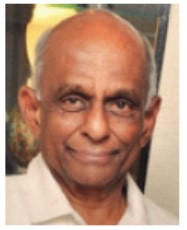
Editor’s Note: For a variety of reasons, Indian classical dance teachers have been reluctant to choose songs for their recitals from the large collection of classy film songs rooted in pure Indian classical dance traditions. Jaya Mani, our veteran dance teacher, breaks this unwritten taboo by staging a program entirely taken from films songs.
On Saturday, May 18th, 2019 at the Sri Venkateswara Temple auditorium, twelve senior students of our veteran Bharatanatyam teacher Jaya Mani presented a unique and enjoyable Indian classical dance program titled in Tamil “Pazhaya Paadal Puthiya Aadal “ (Old Songs & Modern Danceâ€). The songs were from movies dating back to 1948 through 1988 from Tamil movies such as Vedhala Ulagam (1948); Manamagal (1951); Vanjikottai Vaaliban (1958); School Master (1958, Telugu); and Katputli (1957, Hindi). Jaya Mani and her students choreographed the pieces, sometimes independently and sometimes jointly.
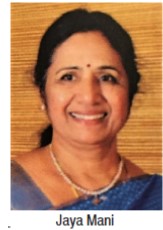
With Deepa, Jaya Mani’s daughter, co-directing, Subha Sriram emceed the program introducing each piece giving the filmi tidbits for each song, such as the lyricist, music director, playback singers, and actors. This kept the audience engaged.
Details of these songs have faded away even for old timers. Many youngsters were probably listening to these songs for the first time. But the lyrics for the songs by great poets (Subramanya Bharathi, Papanasam Sivan, Kannadasan, Udumalai Narayana Kavi and others), the music direction by masters (K.V.Mahadevan, G. Ramanathan, Sankar-Jaikishan…), and the enchanting voices of M.S.Subbulakshmi, M.L.Vasantha Kumari, P. Leela, and Lata Mangeshkar are enshrined in our hearts forever.
Jaya Mani and her students took us back to the golden era of Indian movie classic songs, creatively choreographing the songs to the idioms of the Indian classical dance traditions, adding jatis and abhinayams making them lively and enjoyable.
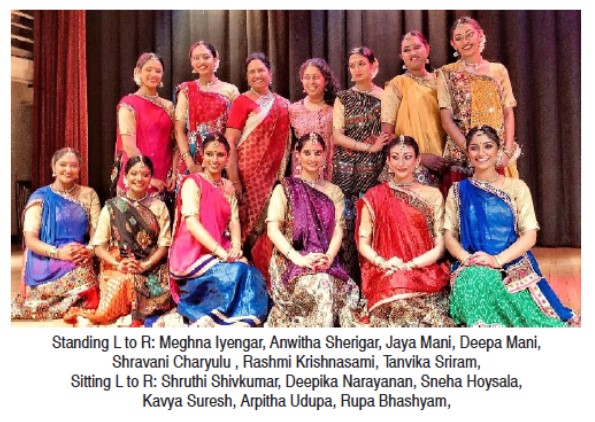
Songs such as Theeratha Vilayattuppillai and Kuravanji dances have been part of the Bharatanatyam repertoire for decades, but dances to songs such as Ellam inbamayam (Deepika Narayanan and Kavya Suresh, Rupa Bashyam and Tanvika Sriram) and Kannum kannum kalandu (Shravani Charyulu and Arpitha Udupa) were real treats.
Jaya and the artistes’ maiden attempt to bring the best of old and new together was enjoyable and made us wish for the good old days when we could sing along, unlike the contemporary movie songs dominated by beats and rhythm with the orchestra overwhelming the human voice.
All the songs used straight film clips running only 3 or 4 minutes, which is necessitated by the time constraints of films. However, there is enough scope in these songs to re-record them by adding more jatis and swarams to expand them as stand-alone 6-to 8-minute pieces as in padams in Bharatanatyam recitals. ♠
Home:
Obituary: V. Udaya Shankar Rao — 1938 to March 26, 2019Â Â Â Â Â Â Â Â Â Â Â Â Â Â
Posted by admin in July 2019, Past issues on July 2, 2019
By K. S. V. L Narasimhan, Moorestown, NJ sim.narasimhan@outlook.com
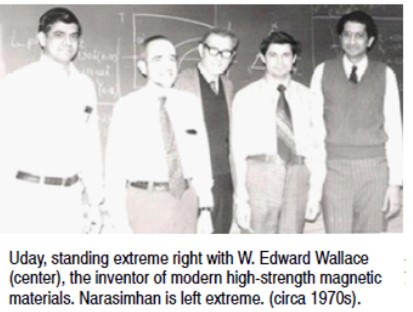
Vallabhajosyula Udaya Shankar Rao, known simply as Uday to his friends, passed away on March 26, 2019 after stoically living through Parkinson’s disease for the last few years. He was 80. He was born on August 4, 1938 in Vijayanagaram, a small town along the Coastal Andhra Pradesh north of Vishakhapatnam. With his mother passing away when he was young, he and his two young-er sisters were raised by their aunt Aadilakshmi, and her husband Voruganti Lakshmikantham.
After obtaining a bachelor’s degree with honors from Andhra University (1958), Uday joined TIFR and earned a PhD in physics from the University of Bombay (1967). In Mumbai, when he was hospitalized briefly, he met his future wife, Cecilia, an attending nurse at the hospital. After their marriage in 1966, they came to the United States in 1968 with Uday’s postdoctoral fellowship at the University of Pittsburgh, where he later became an assistant professor. Uday was highly respected among the post-doctoral fellows .His ability to break down complex tasks to manageable simple steps helped un-ravel the mystery of why rare-earth magnets are so powerful,
After a short stint at U.S. Steel, he joined the Department of En-ergy’s Pittsburgh Energy Technology Center, working on catalysts for converting coal to liquid fuels. In 1989 he received an award for his work from the Pittsburgh-Cleveland Catalysis Society. He retired in 2006.
During the early days of Sri Venkateswara temple, Uday was active with many of us in assisting Raj Gopal in building the temple for Sri Venkateswara. Originally the temple was to be built in Monroeville, where the Hindu-Jain temple is today.
Conflict on the details of the temple resulted in us breaking away to the current location in Penn Hills. The separation of the Indian group was painful, with Uday, myself, and many others pleading for unity in a meeting where tempers were flying high. With no place even to meet, Uday helped us get together in a classroom at the Uni-versity of Pittsburgh where the first draft of the letter for the S V Temple was prepared for mailing to potential donors. Uday was part of the working committee, executive committee and later served as Chairman of the board of trustees.
Uday always wanted to help the needy. In one of our board meetings he wanted the temple to assist a student at Penn State who was wrongfully convicted. He proposed sending $30,000 to assist in paying the legal fees. The board started debating on the amount rather than on the role of temple in these situations. Finally, an amount was sent. The construction of the temple consumed most of our lives from 1973 for several years.
Uday was a great enthusiast of Indian classical performing arts. He himself would go on stage and sing on the Aradhana Days at the temple.
When I moved from Austin, Texas to Pittsburgh to work at the University, Uday and Cecilia took care of me to settle down in Shadyside. As was common in those days, after work most of us went to a pub in Oakland for a few beers. Often spouses joined us as well. Uday would stand up on a chair and start singing the Simon and Garfunkel song “Oh Cecilia! You’re breaking my heart … …â€
Uday was a great tennis player. Afflicted with Parkinson’s and lying in bed still most of the time, when I went to see him, he engaged in conversation with a sharp mind. I teased him: “My best chance to beat you in tennis is now.†He burst into laughter.
S.G.Sankar from Bethel Park, a close friend, read Hindu scriptures for Uday every week. He found peace in both Hinduism and Christianity. Uday helped both his sisters and their families and Cecilia’s family settle down in the US.
Vivek Rao, his son, in the eulogy to his father described Uday aptly: “My father was a calm, kind and gentle spirit. He never gossiped, criticized others or made them uncomfortable. Although he was not a very outgoing person, because of these qualities, he made and kept many friends.â€
Uday leaves behind his wife Cecilia of 50-plus years of mar-riage. He is survived by his sisters, Dr. Indira Varanasi and Dr. Meera Rao; his son Vivek Rao and daughter-in-law Yesoda Nirujogi Rao, and their children Venkat, Jayanth, and Nidhi.
After a funeral mass in Sts. Simon and Jude Church, the mortal remains of Uday were buried at the Mt. Olivet Cemetery, Carnegie, PA on Saturday, March 30, 2019.
Note: Uday Shankar and Cecilia Rao supported the magazine after seeing the very first issue in October 1995. They gave $20 that I distinctly remember even how and I gratefully acknowledge their generosity — K S Venkataraman, Editor ♠
Home:
Supporters Gathered to Celebrate Modi’s Election Victory
Posted by admin in July 2019, Past issues on July 2, 2019
On Thursday, May 23, many admirers of India’s prime minister Narendra Modi in our area under the
banner NRIs 4 Modi-2019 celebrated the totally unexpected big re-election victory of Modi. They gathered at the Triveni Center Banquet Hall in Monroeville and replayed his election speech. For the details more details please contact Harilal Patel at harilalp@yahoo.com.   — By Premlata Venkataraman   ♠
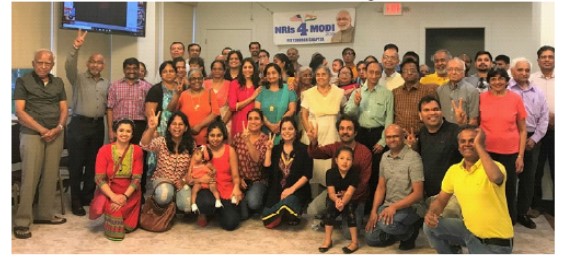
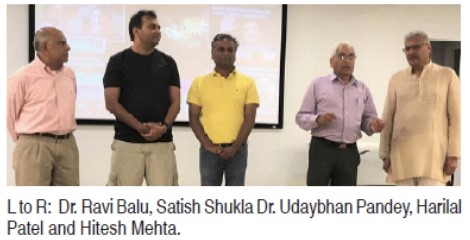
Home:
The Modi Victory — The Best Sweet Revenge
Posted by admin in July 2019, Past issues on July 2, 2019
By Kollengode S Venkataraman, Â ThePatrika@aol.com
Narendra Modi won a super-duper majority any which way one dices India’s national election results of 2019. And he did this despite all projections and a strenuous campaign by media — particularly the English media in India and outside India. This English media — not the Indian regional languages media — was shocked at the level of widespread support for Modi and the total rejection of the combined opposition by voters. Finally, the Indian communists, still wedded to Marxism three decades after it was abandoned by China and Russia (their spiritual masters), received a humiliating body blow.
Given how complex India is in every social, geographic, economic, ethnic, linguistic, religion-based criterion anyone could ever come up with, this is a remarkable success with SIX HUNDRED MILLION voters going to the polls. In many parts, it was summer, with temperatures over 105 F (40 Celsius). It is impossible for most editorial writers of the world sitting in air-conditioned rooms to comprehend how diverse and complex India is, and how comprehensive Modi’s support was in this election.
The global and Indian English media, by choosing to selectively listen and write to their English-speaking elite audience, completely missed the pulse of the ordinary Indian voters living outside the boundaries of Mumbai, Delhi and other large cities. Ved Mehta, a well-known English writer and editor said something like this on the Indian elitist media: They are like corks floating on turbulent waters, believing that they are making the waves.
How did this happen? Let me start with the local. The Post-Gazette reprinted Emily Schmall’s AP story with this title: Modi’s Hindu-nationalist BJP heads for a landslide victory in India’s elections.
Schmall writes, “The victory in India was widely seen as a referendum on Mr. Modi’s Hindu-first politics that some observers say have bred intolerance toward Muslims and other religious minorities, as well as his muscular stance on neighboring Pakistan, with whom India nearly went to war earlier this year.†What are the names and affiliations of, at least, some of those whom she refers to as “some observers�
Incidentally, it is no coincidence that American or UK media, particularly print media, always mention Modi with the self-serving and self-fulfilling epithets like “Fundamentalist,†“Polarizing,†“Hindu,†“Nationalist,†“Right Wing†or other pejorative qualifiers. The Indian English media also uses these condescending phrases: “Saffron Brigade,†“Cow Belt,†and “Sangh Parivar.†Will they ever dare to routinely use similar pejorative terms like “Red Brigade,†“Comrade Gang,†“Marxist mafia,†and other phrases for communists, and similar phrases for the Congress Party? Here are other examples of the mocking use of pejorative terms:
1. The Economist, May 2, 2019 article before the elections titled Agent Orange — Under Narendra Modi, India’s ruling party poses a threat to democracy. It gave this unsolicited advice: “Voters should turf it out, or at least force it to govern in coalition.†The phrase Agent Orange in the caption is enough to tell The Economist’s bias. For readers who do not know, Agent Orange is dioxin, a carcinogenic defoliant the US army sprayed extensively all over Vietnam in the 1960s and 70s in its war to destroy the thick forests which were the Vietcong’s hold outs. The website www.agentorangerecord.com states this on Agent Orange: “While scientists debate over who was exposed to Agent Orange/dioxin… … the fact [is] that… several million Vietnamese were exposed over a period of at least a decade to [dioxin]… …†Thousands of children were born with severe birth defects to women who ingested this deadly defoliant. In today’s world, this would have amounted to a war crime.
And The Economist had the gall to flippantly compare Modi and the BJP to Agent Orange. There was not a whimper from the elite Indian English media on this outrageous phrase used by the influential UK weekly.
2. Bloomberg News’ Mihir Sharma (May 27, 2019) title: Modi’s Win Is a Populist Warning to the World, with this opening paragraph: “It’s a terrible feeling to discover that your country is full of strangers. For some in India, the election of Narendra Modi in 2014, with a majority that India hadn’t seen in three decades, was that moment. … It meant that far more Indians than imaginable were willing to trust a leader with so disquieting a record.†The “some in India†are the India’s anglicized elite living in denial in their own exclusive enclaves.
The Week magazine’s Damon Linker (May 21, 2019): Democracy isn’t dying. Liberalism is “[T]his week, voters… … in EU parliamentary elections could deliver a quarter or more of the seats to the continent’s right-wing populists and nationalists. Meanwhile, exit polls in India suggest that Narendra Modi’s Hindu nationalist party will win re-election when results are announced on May 23…â€
Foreign Affairs, April 11, 2019 Gurucharan Das title for the article was this: The Modi Mirage. The title alone says it all.
One wonders if they would dare to routinely use such pejorative terms “Fundamentalist,†“Polarizing,†“Christian,†“Nationalist,†“Right Wing,†“Bible-Thumping†and others for the GOP, which is essentially dominated by right-wing, flag-waving Red-White-and-Blue Nationalists, including even those waving Confederate flags. Rural, working class, less-educated Christian Fundamentalists, Evangelicals, and Baptists are crucial components in the GOP’s vote-bank political calculus.
To a great extent, the American Democratic Party is “Nationalist†and “Christian†as well, with Catholics, Blacks, Hispanics, newer immigrants, and liberal Jews, Asians and Indians forming a big part of its vote bank.
The fact is, to varying degrees, all political parties all over the world create and sustain, and depend on the locally relevant vote banks to win elections. The Congress Party in India, over the decades, has mastered the vote-bank politics by appeasing minorities, exploiting their insecurities and fragmenting the Hindus along caste lines. So, the global media is disingenuous in trying to isolate and portray BJP as the only culprit.
Besides, politicians in the US prominently project themselves on TV screens during campaigns as pious Christians going with their spouses to Sunday church services. They routinely declare the Christian denominations they belong to. The media routinely asks how the candidates’ religious beliefs would influence their political decisions if they are elected. This places the Jewish, Mormon, and Muslim candidates — not to speak of the polytheistic idol-worshipping Hindu candidates — under a cloud, forcing them to explain and defend their faith and justify their candidacy for elective offices.
Remember, John F. Kennedy was the first Irish-heritage Catholic US president (1961-63), elected 185 years after the republic was formed in 1776. And it took another 48 years, or 215 years after July 1776 for the US to get a Black president in the personage of Barack Obama.
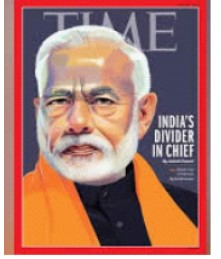
The US news weekly Time, once a flagship among the US news weeklies, barely exists in today’s newsstands. Before the 2019 Indian election, Time ran a story captioned “India’s Divider in Chief†cynically portraying Modi on its cover page, written by Aatish Taseer, who was born in London and educated in exclusive schools in India before moving to the U.S. for his university education. His Wikipedia profile says, “He divides his time between New Delhi and London.†So, I maybe forgiven if I surmise that he may not know India’s complexities by living in Delhi during his sojourns, nor may he understand the UK by living in metropolitan London.
In the UK’s context, the entire city of London is a gated community with exclusive enclaves, where the London elites live among the Middle eastern Sheikhs, Chinese/Indian tycoons, Russian oligarchs and others. These exclusive Londoners have their own values, priorities and culture, cut off from the other hoi polloi Londoners, not to speak of the those in the UK’s hinterland.
This prototype exists in every nation’s capital or big metro areas like Shanghai, Hong Kong, Mumbai, Munich… In New Delhi, they are the Delhi Lutyens, and lately Delhi’s Khan Market Gang. A ton of their exploits are available on the Internet. Today, the Lutyens are no more Delhi-specific. The term has become a metaphor for all elite and exclusive power-brokers in Indian politics wherever they live.
Taseer, who wrote the Time article deriding Modi, is the son of Talveen Singh, a columnist in The Indian Express and Salmaan Taseer, the Pakistani politician and businessman. Talveen Singh, by her own admission (see www.tinyurl.com/TalveenSingh-LutyenDelhi), was raised in the Lutyen’s Delhi. So, Aatish Taseer has been hopping from one exclusive neighborhood in London to another in New Delhi. Obviously, he is no Naipaul.
Then, to soften the blow and to appear fair, in the same issue, Time balanced Taseer’s vitriol on Modi by running another story by Ian Bremmer, with the title, “Modi Is India’s Best Hope for Economic Reform.“ Bremmer is Time’s Foreign Affairs Columnist and Editor-at-Large.
The Indian Brown Saheb English media (both in print and on TV), as expected, lapped up Taseer’s story, giving it wide coverage, implying how bad Modi is, now that even Time — yes, goodness gracious, THE Time — has given its verdict on him even before the election. The Indian English media did not give Bremmer’s story even a tenth of coverage it gave to Taseer’s venom on Modi. This is no accident. The Indian English media folks have vested interest in cultivating on first-name basis Taseer and other writers bearing Indian names (Pankaj Misra, Salman Rushdie, Amartya Sen, Tunku Varadarajan, for example) living in London, New York, Washington DC, California, and other places.
Then after Modi’s landslide victory, the same Time magazine, to recover its integrity — and relevance in the English-reading media world all around the globe — published another story titled “Modi Has United India Like No Prime Minister in Decades,†by Manoj Ladwa, who worked for the Modi campaign in 2014.
But the self-inflicted damage was done both for Time and its surrogates running the English media in India. Indian English Media, which only a fortnight ago gave wide coverage to the Time’s “Divider in Chief†article, made an abrupt U-turn and had a field day berating Time.
One only hopes that the Indian Brown Saheb English media owners, managers, and editors will learn their lesson. But one can never be sure. The wannabe Indian Goras’ lack of self-confidence on account of their lack of awareness of India’s ethos runs very, very deep. ♠
Home:
The New York Times and Narendra ModiÂ
Posted by admin in July 2019, Past issues on July 2, 2019
By Kollengode S. Venkataraman, ThePatrika@aol.com
The New York Times’ editorial bias against the Indian Prime Minister Narendra Modi is well known. Its editorials and editorial Board’s consensus articles have been anti-Modi. Modi-bashing writers bearing Indian names from universities, think tanks, and other literary figures — such as Amartya Sen, Salman Rushdie, Pankaj Misha and Arundhati Roy — are a staple in the Times’ Op-ed page articles. In 2013, before the last general elections in 2015 the Nobel-winning economist, the Bharat Ratna recipient, and Harvard professor Amartya Sen said, he does not want Modi to become India’s prime minister as he does not have secular credentials.
Op-ed pages are supposed to accommodate a diversity of opinions. But on India’s social, cultural and political issues, not only are the NYT editorials are consistently anti-Modi (which is entirely acceptable), but even its news coverage and visuals that go with the stories are also anti-Modi, and OpEd writers appear to be chosen to echo its editorials. For all the freedom of expression the Times professes, often, on India-related articles, it shuts off readers’ comments knowing full well the type of response it would receive from a wide swathe of Indian-American readers.
In this background, the Times published this article (May 20, 2019) by Jeffrey Gettleman with the title without recognizing the irony: The Choice in India: “Our Trump” or a Messier Democracy, (www.nytimes.com/2019/05/20/world/asia/modi-india-election.html)
In the article, Gettleman writes: “These days, it’s not unusual to hear Indians describe Modi as ‘our Trump,’ which is said in antipodal ways, either with pride or scorn.” He should have identified the names and affiliations of those who claim Modi as “Our Trump.”
Gettleman quotes “a well-known political commentator” telling him this on Modi: “Trump and Modi are twins separated by continents.” His article only mentions the name of “the well-known political commentator” without identifying his affiliation. He is Chandra Bhan Prasad. This is unusual for the Times, which rarely uses the names of people without identifying their affiliations. A Google-search revealed that Mr. Prasad is associated with the Center for the Advanced Study on India (CASI) at the University of Pennsylvania, This is how the CASI describes Prasad in its website www.casi.sas.upenn.edu/visiting/prasad :
“Chandra Bhan Prasad is widely regarded as the most important Dalit thinker and political commentator in India today, advocating on behalf of the more than sixteen percent of India’s population who have historically been regarded as untouchable by orthodox Hinduism. Mr. Prasad is a research affiliate on CASI’s Dalit research program and serves as a key advisor to the Dalit Indian Chamber of Commerce and Industry (DICCI). He was the first Dalit to gain a regular space in a nationally circulating Indian newspaper, more than fifty years after India’s independence, quickly attracting national attention and widespread readership … … His articles and books are used by South Asia faculty in universities throughout the world to question longstanding assumptions about caste and Indian society. Prasad studied at Jawaharlal Nehru University in Delhi, where he completed his M.A. and M.Phil. His story and writings can be seen at his website: www.chandrabhanprasad.com.“
We acknowledge Mr. Prasad is a commentator with an impressive pedigree. Nevertheless, he is a partisan, representing and fighting for the Dalits’ causes on a global platform. His erudition and rise from humble background are exemplary, and we respect him for his commitment to his causes.
In India, and in all democracies including the U.S., appeasement vote-bank politics are widely practiced by political parties based on a whole range of local criteria. In India, appeasement politics is successfully exploited by a plethora of pressure groups based on religion, caste, ethnicity and locally relevant minority status. India’s Dalit leaders have been effectively using the vote-bank politics with a rare blend of finesse and muscle power to advance their causes. Good for them. As a Dalit activist and political commentator, Mr. Prasad is free and fully entitled to work for his causes and air his opinion on anyone, anytime, anywhere.
But it is deceitful and disingenuous on Gettleman’s and the Times’ part not to identify Prasad’ affiliation and background. How often do we see the NYT using names in stories without identifying their affiliations?
Now, with this information on Mr Prasad as a Dalit activist on a global platform, and the Dalit leaders’ visceral dislike for Modi, when you read Mr. Prasad’s comment that “Trump and Modi are twins separated by continents,” you get a better understanding and a different feeling. Incidentally, Modi belongs to India’s Backward Caste.
Contary to Mr. Prasad’s characterization that Modi and Trump are “twins separated by continents,” Modi and Trump stand in sharp contrast to each other on a whole range of criteria. See the box below.
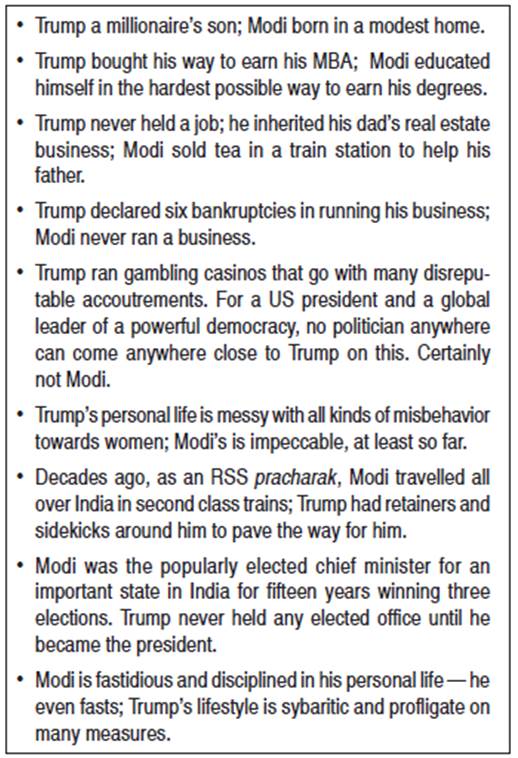
These contrasts aside, Gettleman goes on: “Political analysts say [pray, who are they?] there is no shortage of similarities between the two, including their combative style, their prolific use of Twitter and their talent for stoking nationalism ‘and spreading fear,’ to firm up their bases.”
Show me one politician who does not have a combative style. And if one is not combative, why should one even seek elective office? Combative styles are natural to rulers. There is even a Sanksrit term for it, Rajasic temperament (literally, temperament of the rajas, or kings), in today’s context, the temperament of people wielding raw power, such as elected officials, senior bureaucrats, corporate CEOs and senior managers.
Which politician is not nationalistic? Politicians all over the world — including US Presidents — have used fear to firm up their bases. In our own time, U.S. presidents Kennedy, Johnson, Reagan, Bush-43 and Trump effectively used fear to firm up their base. Bush-43 even went to a costly war in Iraq inciting fear of a nuclear Iraq — a blatantly untrue premise.
Today, with social media and instant communication, nobody has a monopoly over data, analysis, interpretations and opinions, in political and social studies involving races, castes, ethnicities and religions. This includes those sitting in the ivory towers of tenured jobs in endowed chairs in universities, or those spending retirement years in think tanks.
Many of these intellectuals (this is fast becoming a pejorative term these days) — both from the right and left — sit far away from the fields of action, in urban centers, in touch with “like-minded†thinkers living in different time zones, different countries, and different cultures. Predictably, people who interact only with other “like-minded†people end up in echo chambers in different topics, impervious to differing ideas and hypotheses to consider.
Even in the sterile physical and biological sciences, it is painful for someone who has built up his/her whole career on axioms and ideas, to discard them in the face of mounting evidence against them. It is that much more difficult in societal and political studies dealing with class, race, ethnicity, poverty and wealth — and in the Indian context, also involving languages, castes, and religions.
Governing India is a task unlike anything that one can comprehend, given how complex and diverse India is on every criterion known to mankind. India is not like a well-cultivated California vineyard or a Florida orchard. It is like a dynamic tropical forest’s complex ecosystem that supports and sustains countless species of plants, birds, reptiles and animals in perpetual struggle to maintain a semblance of equilibrium.
Trying to understand other cultures through sterile reports, comparison tables, graphs and pie charts, not to speak of GDPs and GDP growth rates, per-capita-this and per-capita-that, though necessary, is just not sufficient. The global English media, particularly in the US and UK, working on deadlines and time- and space-constraints, do not seem to get it.
The Indian English media’s brown sahebs do not care about what the media in Canada, New Zealand, and Australia say on India. These brown sahebs’ current obsession with the US media is understandable. Today, the U.S. is militarily powerful, economically rich and dynamic, technologically innovative, and globally influential on many fronts. And nearly 3 million Indians and Indian-Americans live in the US, most of them in professional jobs. And among them are the Brown Saheb Indians’ classmates, cousins, nephews and nieces, sons and daughters.
But their fascination with the UK is puzzling. It is just a holdover from India’s colonial past. Britain is no more “Great” Britain. And the empire collapsed over 70 years ago, and India became a republic 70 years ago.
In assessing the Indian elections in 2019 the English-speaking West (mainly, US and UK), and their surrogates in the anglicized Indian English media completely missed what was happening on the ground. No wonder they could not recognize the subterranean rumblings.
In a famous Buddhist parable, ten blind men of Hindustan tried to describe an elephant through their tactile experience on the part they touched. Today, the media moguls of Englishtan, blinded by overconfidence and condescension, sitting in New York, London, and Washington, and their deputies in India’s English media houses pass judgement on India based on their partial understanding and fixated opinions. They are partially correct; but they missed the big picture, as it happened in this elections.
Of these two groups, members of the anglicized Indian media are the worst. One can understand the historical biases and prejudices of the western media, like the Times, Time, and the London broadsheets. But the Indian brown sahebs’ unfamiliarity of the Indian hinterland is inexcusable. These Indian brown sahebs are essentially products of upper crust or upper middle-class India, living in Mumbai, Delhi and other metro areas. Most of them are educated in only-English-medium schools from KG onwards, and may have a working familiarity with — vernaculars like Hindi, Punjabi, Marathi, Tamil, Malayalam — And many are further educated in England and the U.S., cut off from India’s ethos on many measures.
With the 2019 elections results going haywire from their predicted outcome, they are in disarray and look foolish. Having gone to “Convent” schools, they are in a confessional mode now.
One hopes now that these brown sahebs will liberate themselves from the Lutyen mindset of looking at Indian through American and British lenses; and as Rajiv Malhotra of the Infinity Foundation has said on many occasions, learn to understand India through Indian lenses. This will not be easy, and will take time, This would involve some serious unlearning and re-learning of their ideas of the Indian subcontinent in all its complexities, warts and all. As any addict knows, freeing oneself from bad habits or recursive thinking, is difficult. This would involve several topics in which they need to learn simultaneously:
1. Learning India’s history through the several regional dynasties going beyond the Mauryas, Guptas, Lodhis, Khiljis, and the Mughals. For example, learning about Satavahanas, Solankis, Kakatiyas, Cholas, Pandyas, Cheras, Marathas, Vijayanagara Empire, and the Sikhs;
2. Familiarizing themselves with Indian’s complex histories in all its social, cultural, linguistic and literary transitions;
3. Learning one or two regional languages, not as ‘vernaculars,’ but in some depth to understand their histories, literary works and the social, ethical, and philosophical ideas they convey;
4. Learning to appreciate India’s pre-Mughal architectural wonders by understanding the civil and structural engineering basis of the temples that have stood for several hundred years before the arrival of Islam, and which are still standing with minimal maintenance;
5. Understanding the basis of India’s unique place in visual arts (sculpting, metal casting, and paintings), and pre-Mughal performing arts (music and dance).
If they do this in some seriousness, they would get a better insight into their own history and ethos in the years ahead. Otherwise, they will become irrelevant in their own time. And what is worse for them, they will become a laughingstock for the rest of India, which they have already become at least in one measure, as the results of the 2019 elections show. ♠
Home:
British Airways Non-Stop Flight to London
Posted by admin in July 2019, Past issues on July 2, 2019
By Premlata Venkataraman e-mail: ThePatrika@aol.com
On April 2, around 6:30 PM the British Airways’ inaugural flight BA-171 (Boeing 787 Dreamliner) landed at Pittsburgh International Airport with fanfare and English paraphernalia decorating the baggage claim area.

Twenty years ago, in the heyday of Pittsburgh being a USAirways hub, British Airways had a non-stop flight from Pittsburgh to London-Ghatwick. Two decades later, we are getting a 4-days-a-week (Tue, Wed, Fri, and Sun) all-year-around nonstop to London Heathrow. The incoming flight departs London around 4:00 PM (local time), and lands at PIT around 7:20 PM. The returning flight (BA 170) leaves PIT at 9:50 PM, landing at London Heathrow at 10:00 AM (local time).

For getting this nonstop flight, British Airways is getting, (or is extracting, depending on your viewpoint) $3 million in subsidies over two years coming from a state economic development fund. Subsidies to air carriers is the norm these days for all second-tier cities for getting nonstop flights to European and Asian destinations.
The Airport Authority estimates that around 50,000 people travel to London annually from our region. It is noteworthy that last September Delta ended its seasonal nonstop from Pittsburgh to Paris, probably anticipating the British Airways nonstop to London Heathrow. ♠
Home:
University of Pittsburgh Delegation Travels Throughout India
Posted by admin in July 2019, Past issues on July 2, 2019
By Pitt Global, University Center for International Studies
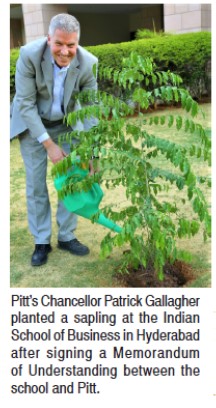
This spring, University of Pittsburgh Chancellor Patrick Gallagher participated in an aarti puja ceremony on the banks of the Ganga in northern India. The ritual held special significance for the chancellor and the Pittsburgh delegation, as the ceremony was directed by the founder and spiritual leader of Pittsburgh’s Hindu Jain Temple, Swami Chidanand Saraswati, who now leads the Parmarth Niketan spiritual retreat center. Hundreds of pilgrims and local residents watched the chancellor and the group light lamps during the daily event. Earlier in the day, Muniji honored the group with warm words of welcome and support for Pitt’s growing investment in the development of Indian studies.
The Rishikesh visit was part of the University delegation’s extensive travels through India to strengthen existing partnerships, lay foundations for new programs and deepen connections with alumni networks.After Rishikesh, the delegation visited Delhi, Mumbai, Hyderabad and Mussoorie for meetings with corporate executives, central and state government officials and senior leadership from educational institutions.
We are grateful for the opportunity to focus on strengthening the intersections between India and the University of Pittsburgh while advancing key collaborations in the areas of innovation and research,†Chancellor Gallagher remarked at the start of the May travels.
Indian studies scholar Dr. Joseph Alter, director of Pitt’s Asian Studies Center, Dr. Ariel C. Armony, vice provost for global affairs, and Dr. Arjang A. Assad, dean of the Joseph M. Katz Graduate School of Business and College of Business Administration, were among other members of the Pitt delegation.
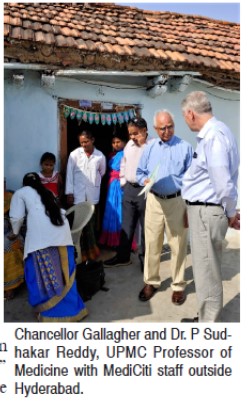
The University signed three new memorandums of understanding in Hyderabad. An agreement with the Indian School of Business (ISB), a premier institution at the cutting edge of Asian globalization, will allow the institutions to work together to develop programs focused on innovations in health care. The agreement with the Indian Institute of Technology (IIT) will result in new faculty research collaborations and student learning programs focused on inclusive innovation. And a broad-spectrum agreement with the Telangana State Council for Higher Education will open the door for Pitt partnerships with multiple institutions in the state.
Outside of Hyderabad, the delegation visited MediCiti, an innovative medical complex serving rural communities established by Dr. P.S. Reddy, UPMC professor of medicine and chairperson of SHARE India.
Three members of the Chancellor’s Global Advisory Council, all Pitt alumni, provided key assistance in planning the trip throughout India, Mr. Aditya Vikram R. Somani, chairman of Everest Tech, Ms. Archana Hingorani, founder of Siana Capital Management, and Mr. Abhishek Singh Mehta, founder and principal of Blue Lotus Investments.
Deepening and expanding its ties in Delhi early in the trip, the Pitt delegation had productive meetings with senior staff from the Office of the President of India and leadership from the American Institute of Indian Studies, the U.S.-India Educational Foundation and IILM University.
A highlight of the Mumbai visit was the chancellor’s speech at the prestigious Asiatic Society, where business leaders and scholars heard him present from the historic Durbar Hall stage about innovative public/private solutions to cybersecurity challenges.
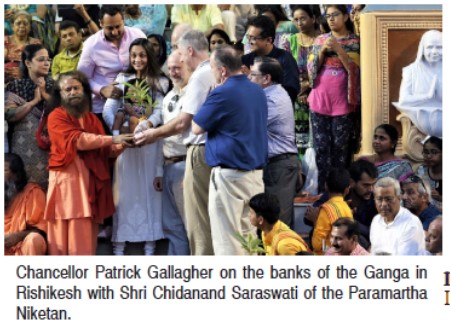
The trip concluded with a visit to the Hanif Center for Outdoor Education and Environmental Study in Mussoorie, where the University runs the popular Pitt in the Himalayas study abroad programs focused on health, leadership and the environment. The delegation had an opportunity to hear from students who worked beside doctors and nurses in outreach mobile clinics serving local villages, and others who participated in field-based leadership programs in one of the most important regions of the world.
The 2019 India trip was a success by many measures. With the help of dedicated faculty and leadership, and with continued strong support from the Indian community of Pittsburgh, the University of Pittsburgh will build on the momentum of the 2019 delegation visit to strengthen its ties within the country.
To learn more about the University of Pittsburgh’s global partnerships and programs, visit www.pitt.edu/global. ♠
Home:
India’s Mother of All Elections
Posted by admin in July 2019, Past issues on July 2, 2019
By Deepak Kotwal, Squirrel Hill, PA
E-mail: deepak@kotwalfinancial.com
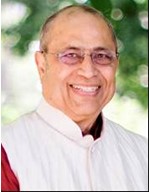
Editor’s Note: Deepak Kotwal, a long-time resident in our area, juxtaposes the Indian national elections with our own elections in the US.
The mother of all elections in the world is over and the results stunned the Western, and even the urban, Indian political pundits. Typically, Western media use suave English-speaking Indian interlocutors to interpret India for the West. These people are educated in elite and exclusive English medium schools, and often have no exposure to Indian history, languages, culture, ethos and India’s hinterland. Their urban and anglicized family upbringing has made it difficult for them to understand the complexities of a multi-lingual, multireligious, and ethnically diverse India, as happened in the 2019 election season. All their projections went haywire, with the Bharatiya Janata Party getting an absolute majority (with 303 seats out of 524), even better than what they got in 2014 (282 out of 543).
As a long-time American resident of Indian origin living in the US, several features contrasting the Indian and American systems come to my mind.
1. In the presidential system of the U.S., it is very difficult to remove the POTUS despite clear evidence of ethical violations, if   not crimes, committed by someone holding the highest elected office in the nation. In the Indian parliamentary  system, if a majority of the members of the parliament lose confidence in the PM, he/she can be removed by a no-confidence vote.
system, if a majority of the members of the parliament lose confidence in the PM, he/she can be removed by a no-confidence vote.
2. Elections in India are conducted by the Election Commission, an autonomous federal body with considerable independence once the elections are announced. In the US, the elections are conducted by state and local governments which have wide latitude in how they go about the process, resulting in gerrymandering and voter suppression rules in many Republican-controlled states. In India, on the other hand, the Election Commission goes to great lengths to ensure that every eligible voter goes to vote. Their logistical efforts to set up voting stations in remote villages for just a few voters are legendary. The Commission has a hard-earned reputation of integrity, fairness and being nonpolitical, having conducted 15 nation-wide national elections and countless elections for state legislatures.
3. Voter suppression efforts in the US emanate from its political/electoral DNA; a country established on land grab, genocide (of Native Americans) and slavery. When the US constitution was adopted in 1789, only property-owning, tax-paying white males were allowed to vote. In deciding how many seats there would be in the Congress, the famous — or infamous, depending on perspective — Three-Fifths Compromise was made. This allowed slave-owning states to count only 3/5th of the number of slaves in determining the population, and the number of representatives in Congress. It took the Civil War of 1865 and the subsequent 15th Amendment of 1870 to grant voting rights to African American slaves, still only to males. The Civil War took place in a country of only two ethnicities (European whites and African Slaves), one language (English), and one religion (Christianity). Contrast this with the enormously complex India, shown in the box above.
4. Even though the Confederates lost, subsequent years saw the rise of Jim Crow segregation to 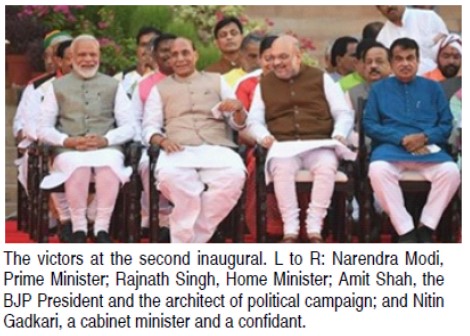 deny political gains for former slaves. Suppression of Black voters and efforts to show that Whites were still in charge were strengthened, the symbol of which are the monuments for confederate generals installed after the war, even though they lost the war.
deny political gains for former slaves. Suppression of Black voters and efforts to show that Whites were still in charge were strengthened, the symbol of which are the monuments for confederate generals installed after the war, even though they lost the war.
5. The verb “to grandfather†(to exempt from new legislation or rules) arose from these efforts. Since the newly freed slaves were illiterate, a new requirement was promulgated that a voter must be able to read and write. This would have resulted in disenfranchising all the whites who were illiterate. To get around it and to enable the affected whites to vote, an exception was carved out — “if your grandfather was allowed to vote, then you get to vote.†Obviously, the newly freed slaves’ grandfathers were not allowed to vote. Hence the VERB grandfather!
6. Women fought through the Suffragist Movement to get voting rights obtained in the 19th Amendment adopted in 1920, 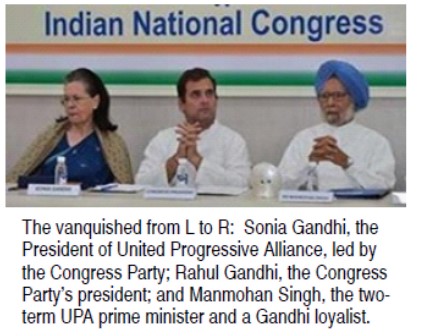 131 years after independence in 1776. Only in 1924 were Native Americans allowed to vote. Voting rights to all was granted in the Indian Constitution at the outset of 1950. The vigorous efforts of the Indian Election Commission to facilitate all to vote stands in stark contrast to US history, where we still are discussing voter suppression efforts.
131 years after independence in 1776. Only in 1924 were Native Americans allowed to vote. Voting rights to all was granted in the Indian Constitution at the outset of 1950. The vigorous efforts of the Indian Election Commission to facilitate all to vote stands in stark contrast to US history, where we still are discussing voter suppression efforts.
An undisputed star of the mechanics of the Indian election is the Electronic Voting Machine, each costing about US$250. These are designed and built by Bharat Electronics Limited, Bengaluru; and Electronics Corporation of India, Hyderabad. They are stand-alone battery-operated digital devices not connected to the internet. The same engineers who work on India’s atomic weapon systems and ballistic missiles worked on designing the EVM. In the US, voting methods vary from state to state. Some states still use paper ballots. With these electronic devices in India, the election results are out within fifteen hours after the start of the counting of over 600 million votes.
The US likes to bill itself as the beacon of democracy in the world. The next time you read a patronizing article about Indian elections in the Western press, just be knowledgeable about the history of the mechanics of US democracy vs. the Indian one. ♠
